FINAL REPORT: Optimized Shrub System: Improving Cowpea Yields and Strengthening Smallholder Resilience
February 10, 2024
Feed the Future Innovation Lab for Legume Systems Research
Final Report
Project Title: Optimized Shrub System (OSS): An Innovation for Improving Cowpea Yields and Strengthening Smallholder Resilience in Senegal
Project Code: AOI 1: Integration of legumes into sustainable smallholder farming systems and agricultural landscapes
Research Country Focus: Senegal
Dr. Richard P. Dick
Co-Director and PI Soil Quality/Agronomy Professor Soil Microbial Ecology The Ohio State University, 2021 Coffey Road Columbus OH 43210-1085 Email: dick.78@osu.edu Phone: (1) 614-247-7605
Dr. Moussa Diangar
Co-Director and Co-PI Cowpea Variety Trials ISRA-CERAAS Bambey, Sénégal Email: diangarfils@live.fr Phone : +221 77 8803154
Dr. Ibrahima Diedhiou
Co-PI Plant Ecology/Water Relations University of Thiès Thiès, Sénégal Email: idiedhiou@univ-thies.sn Phone : +221 7765825 16
Ms. Amanda Davey
Co-PI Gender & Nutrition/M&E Global Water Institute, Ohio State University Columbus OH 43210-1085 Email: davey.22@osu.edu Phone: (1) 614-292-3432
Executive Summary
West Africa suffers from recurring drought and degraded soils which limits productivity of cowpea, an important source of protein and income for rural households in the Sahel. This project pilot tested and adapted the Optimized Shrub System (OSS) to improve cowpea production in Senegal. OSS utilizes 2 indigenous shrubs (Guiera senegalensis and Piliostigma reticulatum) at densities of 1200-1500 shrubs/ha that includes annual incorporation of aboveground biomass – a system our research (34+ refereed journal articles) has shown dramatically increases crop yields (pearl millet and peanut), remediates degraded soils, and profoundly, shrubs can “bio-irrigate” adjacent crops – a powerful mechanism to combat in-season drought. On-farm evaluation in collaboration with 30 farming households pilot testing a locally adapted, gender sensitive OSS in side-by-side comparison plots with the Traditional Management System (low shrub density and annual burning of coppiced biomass) showed that after three years, yields of millet increased by 54% with OSS over the TMS when managed by farmers. Eight cowpea varieties that varied in duration and phenotypic properties were tested to identify superior lines for OSS. Five cowpea varieties in the same study had cowpea seeds analyzed for four nutrients which showed that OSS increased seed content of 3 of the 4 nutrients. Considering both productivity and nutritional value, the varieties Kelle and Yacine were the top performers and best adapted to be grown under OSS management. Two MS students were trained, and project outputs have been and will continue to be shared through journal publications, OSS Field Days, website blogs, and the OSS SAWBO video as well as through our OSS-focused non-profit, Agro-Shrub Alliance.
Project Objectives and Associated Activities
This project leveraged outputs from a USAID Peanut Innovation Lab funded project entitled: “Optimized Shrub System (OSS): an Innovation for Landscape Regeneration and Improved Resilience for the Peanut-Basin of Senegal,” specifically utilizing the locally adapted OSS that was developed through focus group sessions and surveys, 30 OSS trained farming households, OSS and no shrub plots maintained at longterm sites at Keur Matar and Nioro, and piggy backing on an OSS Field Day. This enabled an efficient use of resources and resulted in mutually beneficial synergies between the two projects.
Objective 1 — On-Farm Pilot Testing of OSS for Cowpea Production
This was a collaboration with farmers in designing and implementing an on-farm comparison of the Traditional Management System (TMS) with OSS. Two sets of farmers located in the northern and southern regions of the Senegal Peanut Basin established adjacent cropped fields (0.05 ha) that compared the Traditional Management System (TMS) that has low shrub density and burning of shrub coppiced biomass with the Optimized Shrub System (OSS) (1,200 shrubs ha-1 & all shrub biomass annually cut and incorporated into soils) for 3 years. The northern site at Meckhe used Guiera senegalensis as the companion intercrop whereas southern site near Nioro utilized the shrub Piliostigma reticulatum.
Millet and peanut crop growth and soils data were collected for all 30 participating farms with each having the paired fields of TMS and OSS cropping systems comparisons. In addition a cowpea relay treatment that involved the 1st sowing on July 28 and the second on September 04, 2022 at Nioro and August 10 and the second on September 03, 2022 at Kuer Matar. Both sequential cowpea crops were successfully established in millet fields of a subset of the pilot testing farmers but unfortunately, grazing animals consumed the second crop as this crop was growing after the millet harvest when livestock are released and forage fields for fodder; clearly indicating the need for fencing for relay cropping cowpea.
Objective 2 — Screen cowpea cultivars for superior performance under OSS
Eight phenotypically diverse (including duration) cowpea cultivars were tested under OSS and TMS to determine superior lines for OSS. The cultivars included 5 newly released lines and Yacine, a variety highly valued in Senegal. To determine if cultivar selection affects cowpea performance under OSS, two experiments were conducted in 2021 and 2022 at longterm experimental sites that have been comparing +OSS and -OSS since 2005 under peanut-pearl millet rotation and varying rates of NPK fertilizer. One site was in the southern region of the Peanut Basin near Nioro (700mm annual rainfall) that had Piliostigma reticulatum as the companion shrub and at the northern site near Thies at Keur Matar (450mm annual rainfall) with Gueira senegalensis as the companion shrub. The experimental design was a completely randomized block 2 X 8 factorial with 4 replications and the following treatments: 2 management system (+OSS and -OSS) and 8 cowpea cultivars (Leona, Sam, Yacine, Lizard, Kelle, Bambey 21, Thieye and Mouride). Crops were planted in late July at Nioro and early August at Kuer Matar.
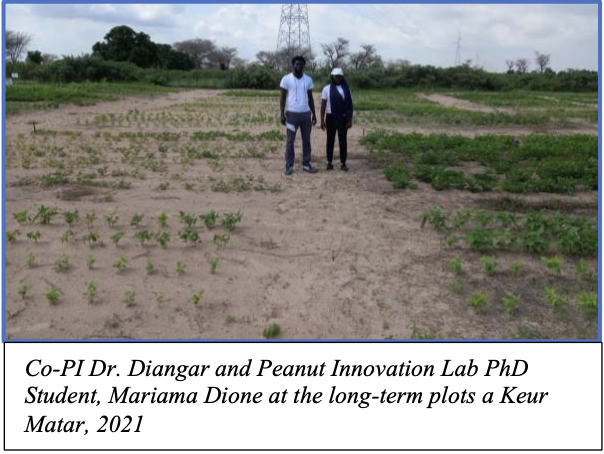
Objective 3 — Crop Productivity, Soil Water, and Crop Water Stress Measurements
Parameters measured annually on crops and cowpea included plant height. biomass and yield. The soil measurements were plant available nutrients, pH and total N and C. At baseline, in 2019 and 2023 all onfarm sites had soil samples taken for soil chemical and physical properties. Baseline soil data has been collected and organized. The follow-up sampling of December 2023 has had lab analyses completed with data analysis in progress.
Objective 4 — Dissemination of findings and Research Translation
Various outreach activities were implemented. This included dissemination of project results on websites, a field day and participatory cowpea workshop with farmers. In addition, a Scientific Animations Without Borders video was developed for farmers, extensionists, professors, and NGOs entitled, “Using Native Shrubs to Increased Soil Health and Crop Yield.”
Project Accomplishments and Research Results
Cowpea Varietal Testing under OSS
Nioro – Long-term plots – Intercropping with Piliostigma reticulatum
In both 2021 and 2022 there was a significant effect (P<0.001) for both factors, management system and variety. In 2021, averaging across all 8 varieties the yield under OSS was 1,557 kg/ha with Yacine (2,007 kg/ha) and Kelle (1,960 kg/ha) being the highest yielding varieties with OSS (Table 1). In contrast, -OSS, averaged across all 8 varieties had a yield of 175 kg/ha with Leona (307 kg/ha) and Yacine (240 kg/ha) being highest yielding varieties under TMS management. In 2022 the results were similar (Table 2) but overall lower because of reduced seasonal rainfall. None the less, +OSS averaged across all 8 varieties had a yield of 962 kg/ha compared to -OSS with 133 kg/ha. Under +OSS Thieye (1,131 kg/ha) and Kelle (1,124 kg/ha) being the highest. The results indicate that Kelle was more consistent as a high yielding variety both years which makes it a good recommendation for interplanting with P. reticulatum.
The 100 seed weight is presented in Table 3 for Nioro. Unlike Kuer Matar with G. senegalensis, there was a significant effect of +OSS over -OSS at Nioro with P. reticulatum as the companion plant. Furthermore, there was a significant effect of variety. However, there was not a clear pattern of 100 seed weight corresponding to seed yield of Table 1.
An important component of cowpea is the above ground biomass production as it is a desired livestock fodder that also can be a source of income for farm households. As with yield +OSS significantly improved biomass production at 1,711 kg/ha when averaged across varieties over 962 kg/ha for -OSS. The highest yielding biomass varieties under the + OSS were Leona (2,012 kg/ha) and Kelle (1,836 kg/ha) which does correspond to seed yields, with these two varieties ranking 3rd and 2nd in seed yield for 2021.
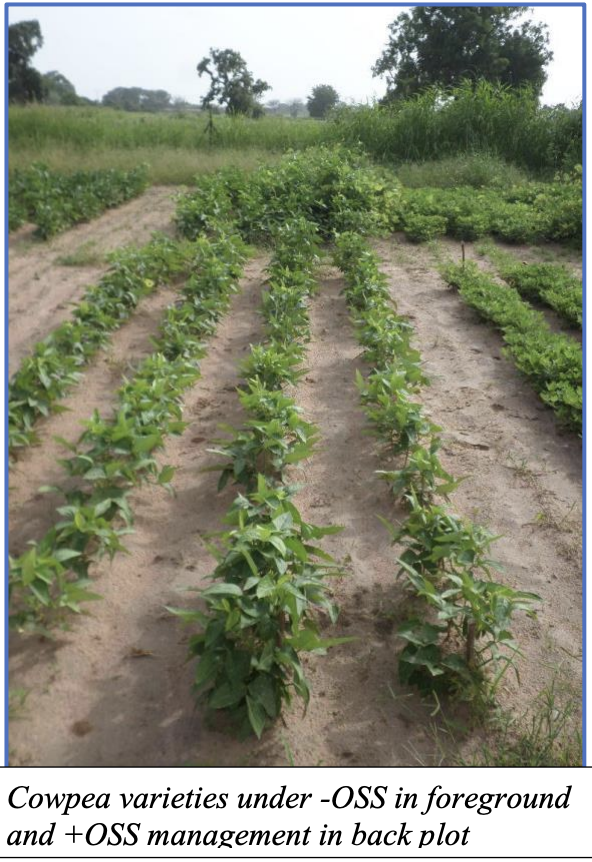
Kuer Matar - Long-term plots – Intercropping with Guiera senegalensis
In 2021, averaging across all 8 varieties the yield under OSS was 126 kg/ha with Leona (253 kg/ha) and Mouride (186 kg/ha) being the highest (Table 1). Whereas, -OSS, averaged across all 8 varieties had a yield of 94 kg/ha with Kelle (147 kg/ha) and Yacine (144 kg/ha) being highest. This yield response appears to have more to do with increased production of number of seeds over an increase in individual seed weight. This is shown in Table 3 where although there was a slight increase in the average across varieties of 100 seed weights for +OSS it was not at P<0.05. Reinforcing is that Mouride had the second highest yield but at the same it had one of the lowest 100 seed weights.
In 2022 the -OSS had no harvestable pods for any of the varieties of the traditional management system. However, biomass was measured for both +OSS and -OSS, which averaged across all 8 varieties the Cowpea varieties under -OSS in foreground and +OSS management in back plot 5 fresh biomass yield was 2,510 kg/ha for -OSS compared to +OSS that averaged 4,401 kg/ha which was significant (P<0.01) (data not shown).
As with seed yield, biomass yields were considerably lower at Kuer Matar compared to Niora. As with yield +OSS significantly improved biomass production at 625 kg/ha when averaged across varieties over 434 kg/ha for -OSS. The highest yielding biomass varieties under the + OSS were Kelle (891 kg/ha) and Leona (693 kg/ha) which does correspond to seed yields, with these two varieties ranking 3rd and 2nd in seed yield for 2021.
Contrasting Site and Shrub Species Response to OSS
Ideally it would be preferred that a few varieties would consistently be the best performers across both regions and shrub type. The variety that comes closest to that is Kelle which in both seed yield and biomass production was either first or second in rank for these properties at both Kuer Matar (G. senegalensis) and Nioro (P. reticulatum). From our previous research on these sites, it is expected that yields would be lower at Kuer Matar which we have repeatably shown for peanut and millet. This is because Kuer Matar is further north that has less annual rainfall and where the soils are inherently of lower fertility because they have very little clay. However, on a relative basis the drop in cowpea productivity between the 2 sites is somewhat more than what we have found for peanut and millet. It may be because of weather and possibly pests that hit at flowering, as cowpea is very sensitive to negative impacts at flowering – particularly high night temperature exacerbated by drought and insects such as thrips. In 2022 this may well have been due to a heavy rain (plus heavy wind) at flowering that hit at Kuer Matar but not Nioro, that can severely damage flowers and result in significant reduction in pod set. 2021 was a low rainfall year, which was more severe at Kuer Matar which may be a factor in the overall low yields at this site, as drought at the preflowering and flowering stages on cowpea is particularly devastating. Hence, we do not think it can be concluded that P. reticulatum is preferred over G. senegalensis as a companion plant for cowpea. Further research across the north-south rainfall gradient is needed to determine whether cowpea prefers P. reticulatum over G. senegalensis.
The lack of pod production in 2022 in the -OSS plots reflect how degraded this soil has become at Kuer Matar with the traditional system that is depending only on crop residues as organic inputs. This is consistent with previous research on these plots showing very low production of millet and peanut in recent years.
Effect of OSS on Cowpea Nutritional Value (Cross Cutting Theme)
Besides crop productivity it is important to determine if OSS produces more nutritious cowpea given the widespread consumption of cowpea among low income, rural households as a food security strategy. As such, we explored whether cowpea grown under OSS is of higher nutritional value than cowpea grown in the traditional system involving shrub removal and burning. Although we know from our work that five macronutrients (N, K, Ca, Mg, S) and two micronutrients (Mn and Cu) were significantly greater in the soil of the shrub plots compared to the soil of the no shrub plots (Bright et al. 2017), it is unknown if this translates to higher quality cowpea seeds. This research was carried out on 5 varieties of cowpea grown at the two longterm research plots located in Keur Matar (Guiera senegalensis) and Nioro (Piliostigma reticulatum). Nutritional analyses included: protein, iron, phytate, and ash content of the seeds. The seeds harvested in the field were dried, sorted and sent to the food technology laboratory (ITA) in Dakar.
In plots with P. reticulatum, the best nutritional performances were obtained with: Yacine (0.74g/100g DM) and Leona (0.70g/100g DM) for phytate however there was no significant effect of +OSS on phytate content (Table 5); Yacine (29.53g/100g DM) and Leona (21.53g/100g DM) for protein content with a significant (P<0.05) +OSS effect (Table 6); and Kelle (3.98g/100g DM) and Sam (3.825g/100g DM) for ash content with a significant (<P0.05) +OSS effect (Table 7); and Yacine (345µg/100g DM) and Leona (230µg/100g DM) for iron content with a significant +OSS effect (Table 8).
In plots with G. senegalensis, the best nutritional performances were obtained with: Sam (0.71 g/100g DM) and Kelle (0.70g/100g DM) for phytate however there was no significant effect of +OSS on phytate content (Table 5); Sam (23.94g/100g DM) and Kelle (23.94g/100g DM) ) for protein content with a significant (P<0.05) +OSS effect (Table 6); Sam (4.23g/100g DM) and Kelle (4.275g/100g) for ash content with a significant (P<0.05) +OSS effect (Table 7); and Yacine (345 µg/100g DM) and Leona (230µg/100g DM) for iron content with a significant (P<0.05) +OSS effect (Table 8).
Across both experimental sites with the associated shrubs and nutrients, Yacine and Kelle were the most common varieties to have the highest nutrient contents. Except for phytate all the other nutrients +OSS was a significant factor in increasing nutrient content.
On-farm Pilot Testing of OSS
Crop production averages across the 15 participating farmers in the southern Peanut Basin near Nioro are shown in Tables 9 and 10. Each farmer had paired fields where one plot had the OSS established by increasing shrub densities of P. reticulatum to >1200 shrubs/ha in 2019 and subsequent years the coppiced biomass was chopped and returned to the soil.
Both millet and peanut yields were significantly increased with +OSS over the Traditional Management which started in the second year since the treatments were imposed. Two years after imposing the +OSS treatment, averaged across all 15 farmers, peanut pod yield was 2,493 kg/ha compared the traditional system that was 1,946 kg/ha or 28 % increase (Table 9).
Table 10 shows a millet grain yield increase of 300 kg/ha averaged across all 15 fields with +OSS which is a 54% increase over TMS. The average yield was 853 kg/ha with some farmers obtaining > 1380 kg/ha when cultivating with OSS. This was three years after imposing the Optimized Shrub-intercropping System, which over the first three years of our long-term research experiment at Nioro with P. reticulatum had yields ranging from no significant to 30 % increases (Dossa et al., 2013). Whereas, subsequently from 5 to 10 years yields increases with +OSS ranged from 77 to 130 % over -OSS (Bright et al., 2017). Thus, we would expect that the farmer yields would continue to increase.
Outreach and Dissemination Activities
Participatory Workshop
In collaboration with ILLSR PI from the University of California, Riverside, in February 2021, project Co-PI Moussa Diangar co-hosted a Participatory Evaluation of Cowpea Traits Workshop. The two-day workshop included 56 end consumers of diverse backgrounds and of which, 38 were women. Based on various characteristics, participants were asked to rank their preferences. The 8 varieties piloted in this project did very well with the variety Yacine ranking number 1 by 52 of the participants.
Field Day
A group of farmers, researchers, students, extension specialists, and NGOs gathered on October 7, 2021for the inaugural Field Day of the Optimized Shrub System (OSS). Project Co-PI Dr. Diangar, pictured below, presented the results of his OSS/cowpea research along with the Peanut Innovation Lab researchers.
For more information about the day, please visit this link: Field Day
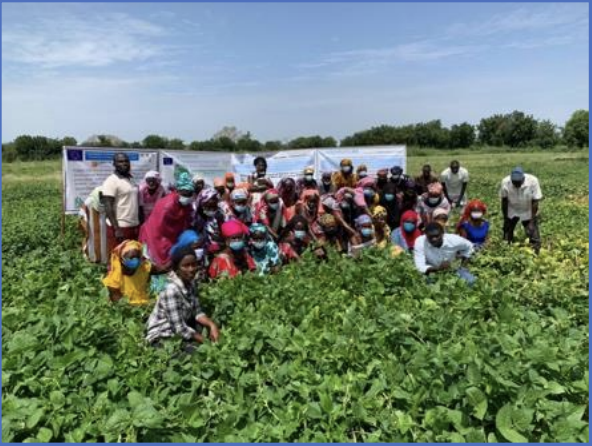

Additional links where the research has been shared:
Bio-Irrigation for the African Sahel
WASI (West African Shrub Initiative)
Farmers in Senegal learn to respect a scruffy shrub that gets no respect
Academic Training
Two MS students were trained. Nafissatou Diallo (ENSA, Universite de Thies) did her thesis research on OSS and TMS performance under farmer management in the pilot testing project. Ngane Niang (Universite Assane Seck) conducted thesis research on cowpea varietal performance in the presence and absence of the OSS with Piliostigma reticulatum as the shrub companion plant type.
Development of Shrub Management Video (HICD Cross Cutting Theme)
Through the resiliency activities we were able to secure additional funding to produce a Scientific Animations Without Borders (SAWBO) to promote non-thermal shrub management. As noted above under Objective 4 Activities, we are promoting OSS through field days, symposia, website, blogs, social media posts, and by word of mouth, which are important tools for research translation and sharing OSS, however, we were needing a tool that can reach a broader audience not only in Senegal, but across the entire Sahel where OSS is applicable. In addition, the COVID 19 pandemic has highlighted the need for alternative methods for transferring knowledge. SAWBO is the ideal tool for widely sharing the OSS technology. For one, OSS is a clear, simple innovation that could be easily communicated in a short, animated video format. We are now distributing the SAWBO through our communication channels including websites, social media, and more formally at conferences. Importantly, the video will be used as a learning tool in agronomy courses at École Nationale Supérieure d'Agriculture (ENSA). Prof. Richard Dick will share the video in his soil science course at Ohio State, exposing U.S. students to science-based agroecology practices. To reach more W. African farmers, the video has been translated into French and Wolof. The video can be viewed at the following link:
Other expected outputs are two research publications and a second OSS Field Day in October 2023 to share the research outputs with a broad stakeholder audience including farmers, extensionists, researchers, students, NGOs, and policymakers. Because of Covid-19 we had to limit our inaugural field day attendance to 40. For this one we will expand our numbers up to 150. Additionally, we will take this opportunity to share with farmers the best cowpea seed varieties for OSS management.
Partnership Development and OSS Scaling Opportunities
Throughout the duration of the project, we worked to build new partnerships whenever possible to continue to expand our network and search for potential collaborators and synergies. This included a site visit to the Beer-Sheba project which is 100 hectares of naturally regenerating forest situated among Serer farming villages and deforested rangeland in the region of Thies. At 15 years old, this ecosystem continues to mature, allowing for observation and study of wildlife, birds, and insects that had all but disappeared from the region. The project has an internship and training program to cultivate stewardship of the region’s flora and fauna. They asked for training on shrub propagation and the Optimized Shrub System to establish a small demonstration plot. Another new relationship formed before COVID 19 is with Trees for the Future, an organization implementing the Forest Garden Approach in Senegal and other parts of Africa. The Forest Garden is an agroforestry-based, irrigated farming system for the production of high value, high nutrition organic fruits, vegetables, and nuts while also providing fodder, fuelwood, and fiber on one-half to one-hectare plots. Project PIs visited several Trees for the Future forest gardens. Through this engagement we have submitted a joint proposal to the Green Climate Fund that has been endorsed by Senegal’s National Designated Authority. The project will implement forest gardens for irrigated vegetables and OSS for rainfed cereal and legume crops, scaling OSS with 10,000 farmers, and further encouraging non-thermal shrub management on an additional 8,400 hectares.
We will continue to use the platform that this project helped to build for scaling OSS through our non-profit Agro-Shrub Alliance where we recently received another round of funding from the Food, Conservation & Health Foundation to study nematode abundance in OSS vs. TMS for irrigated vegetable production with partner, GreenAgro. Further, we will be continuing our work with the pilot farmers from this project creating an Agro-Shrub Farm Network working with these village level change-makers to disseminate OSS. We recently submitted a proposal to the USDA Foreign Agricultural Service to study different scaling mechanism in a two-year project. If funded, we will pilot test OSS Farmer Field Schools and co-develop with famers carbon credit contracts to identify appropriate economic incentives for OSS adoption. Finally, we will continue to look for funding to support additional OSS/Cowpea research.
APENDIX – PROJECT DATA
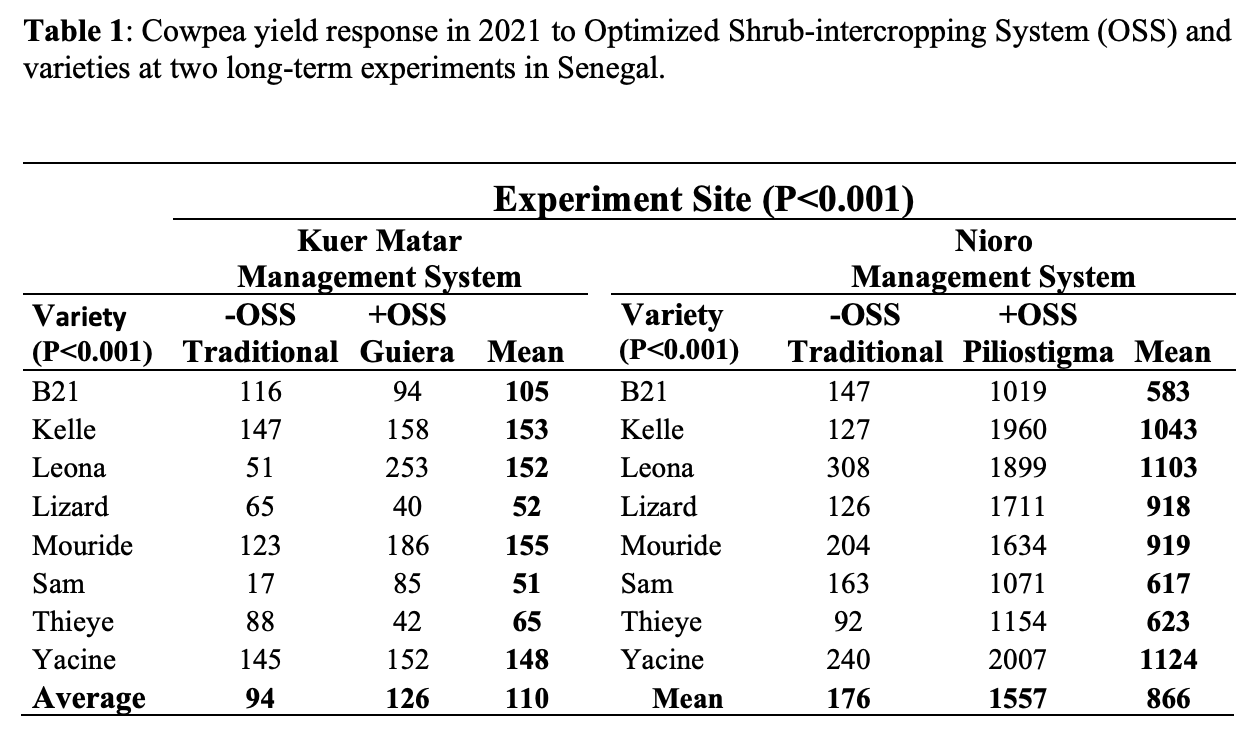
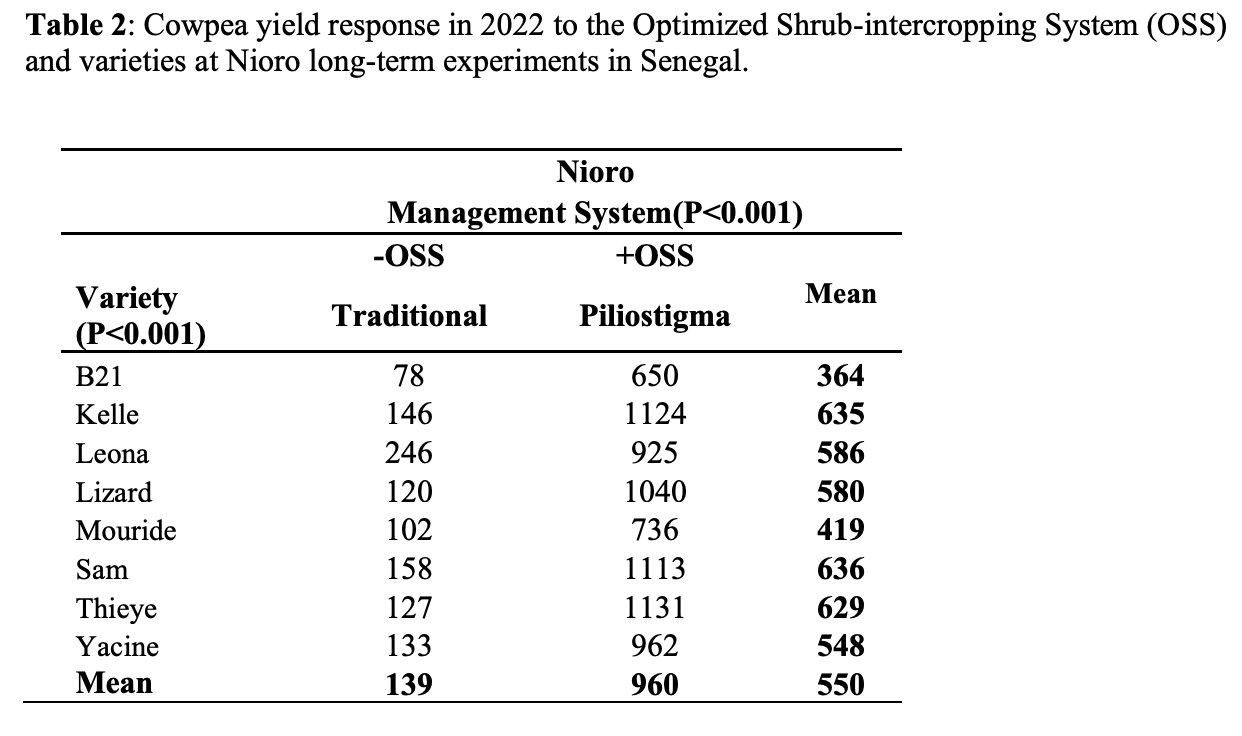
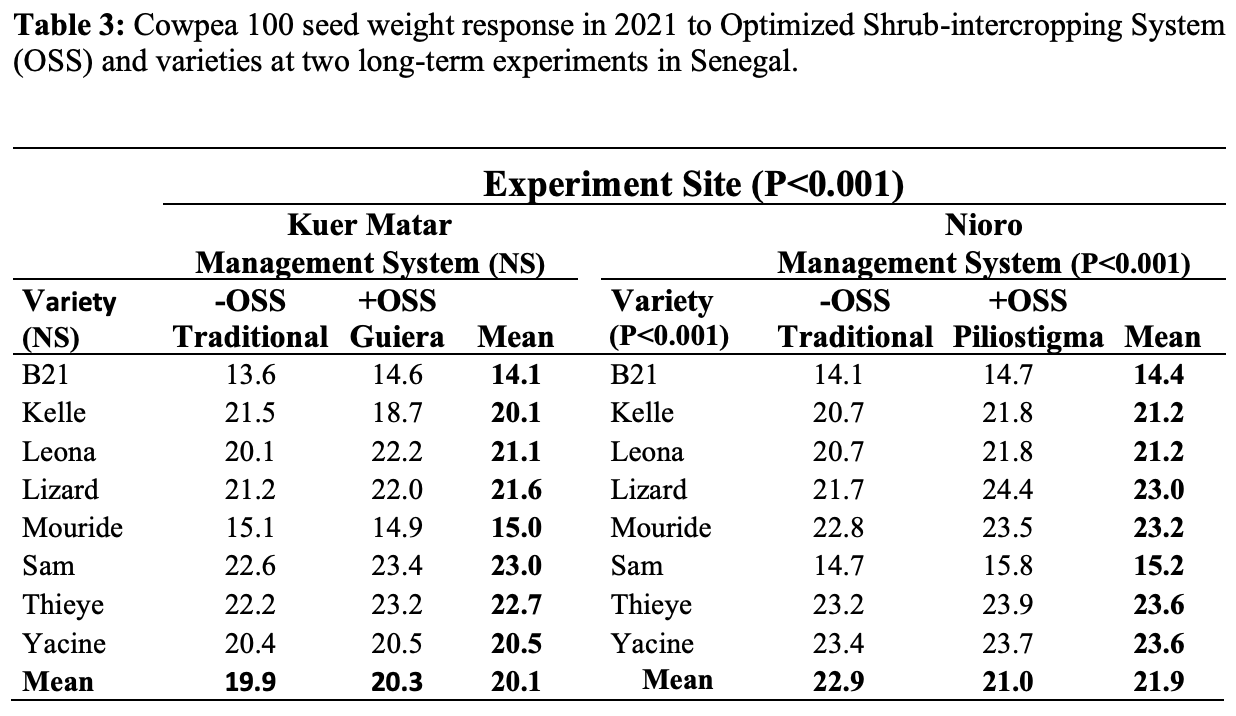
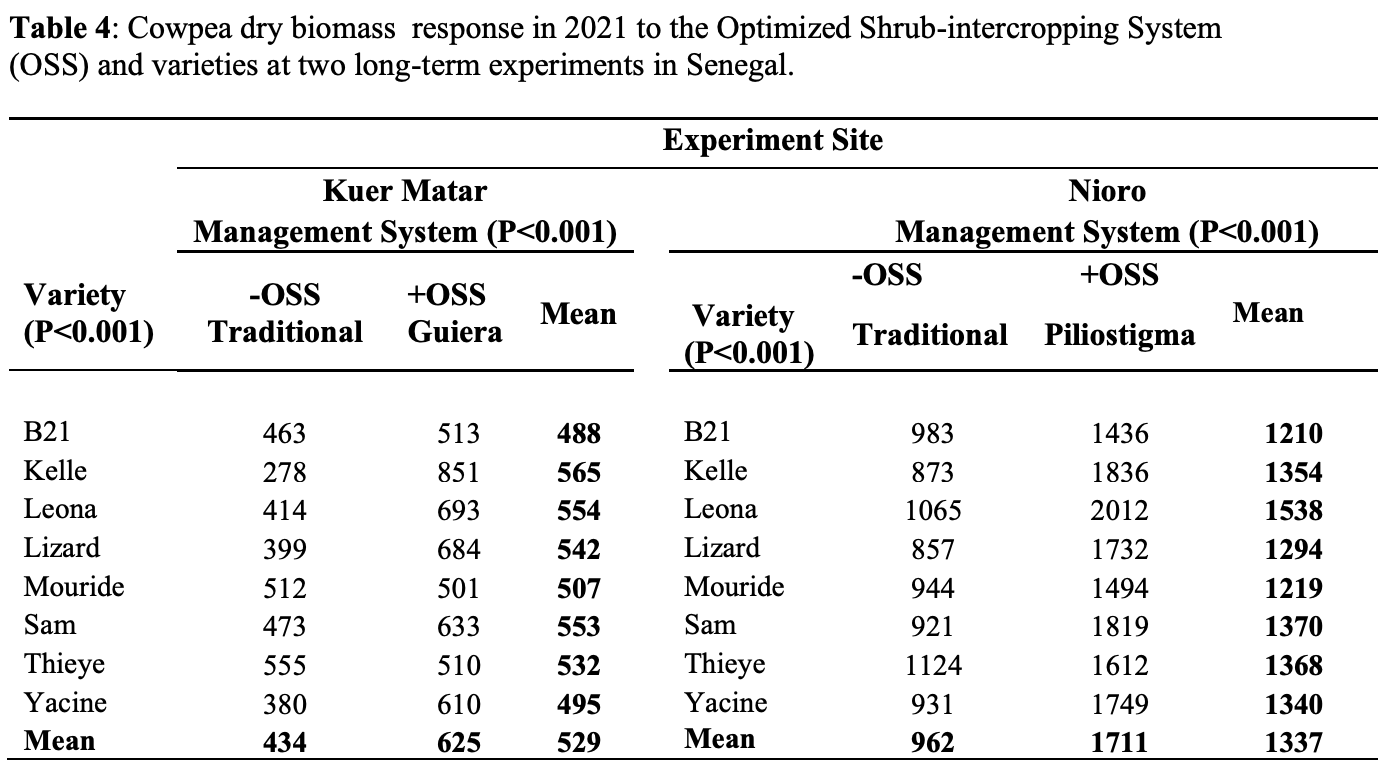
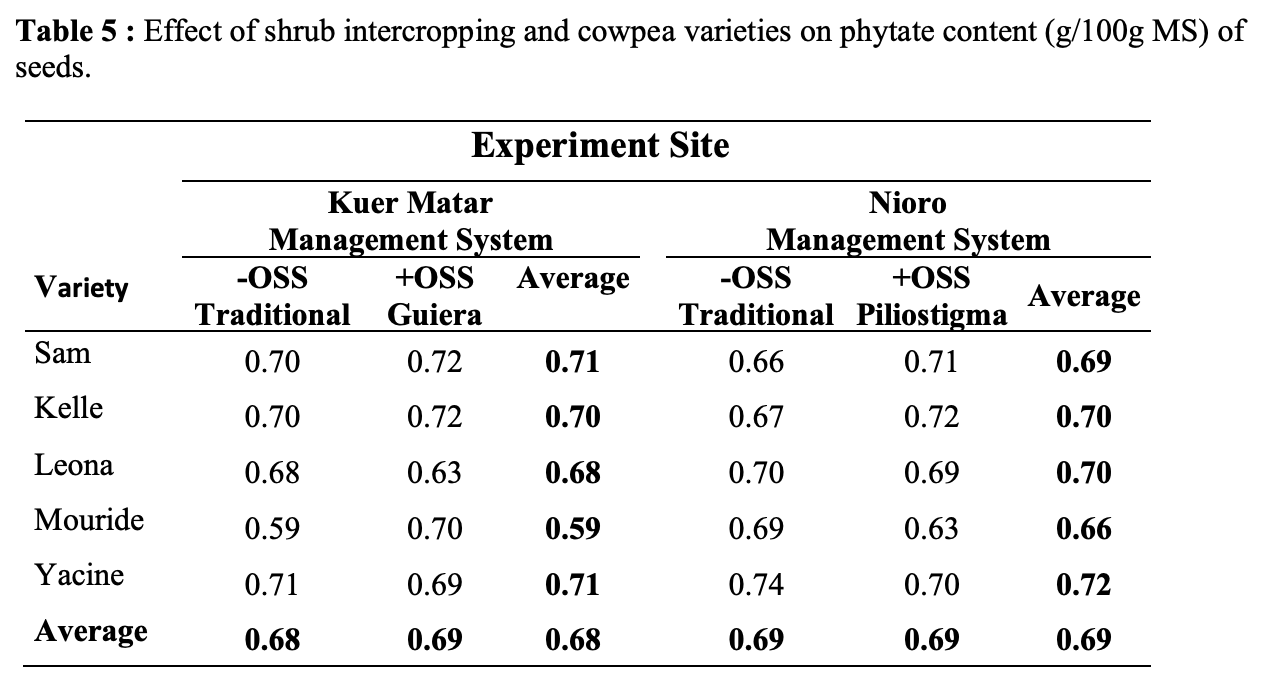
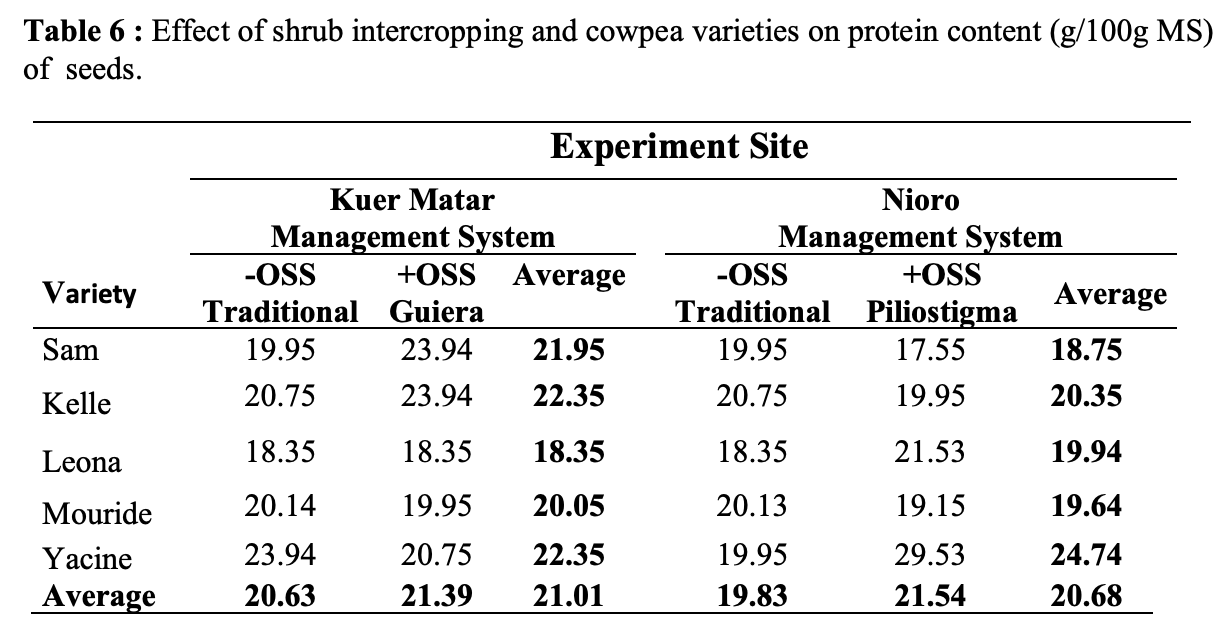
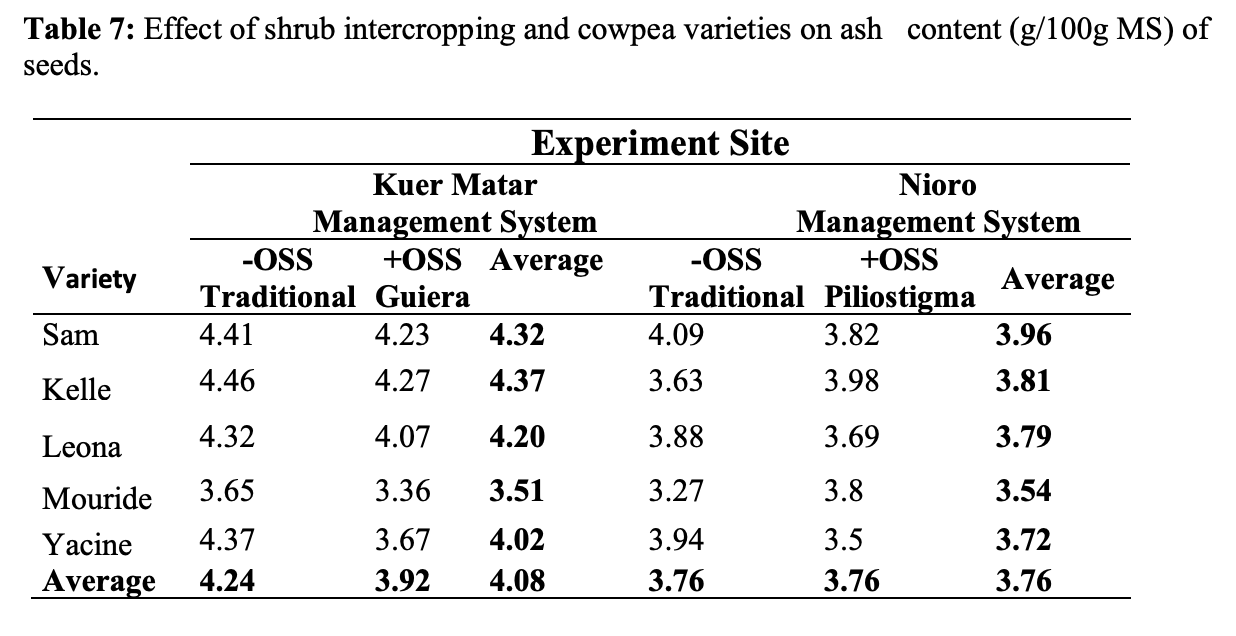
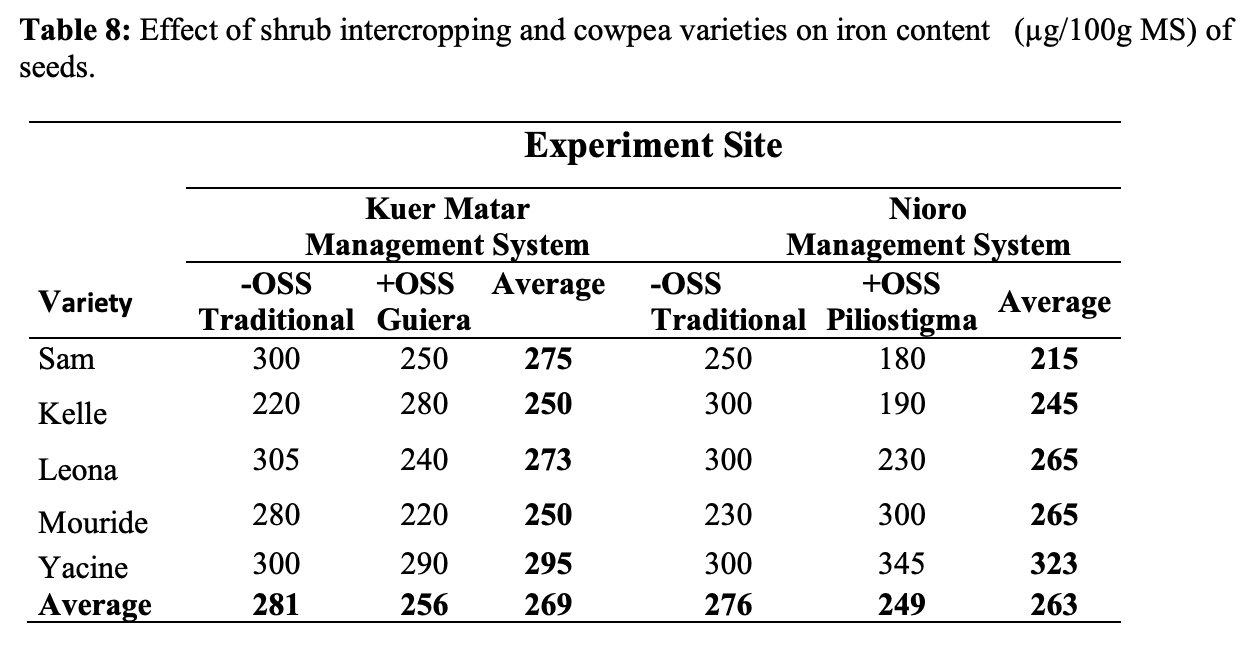
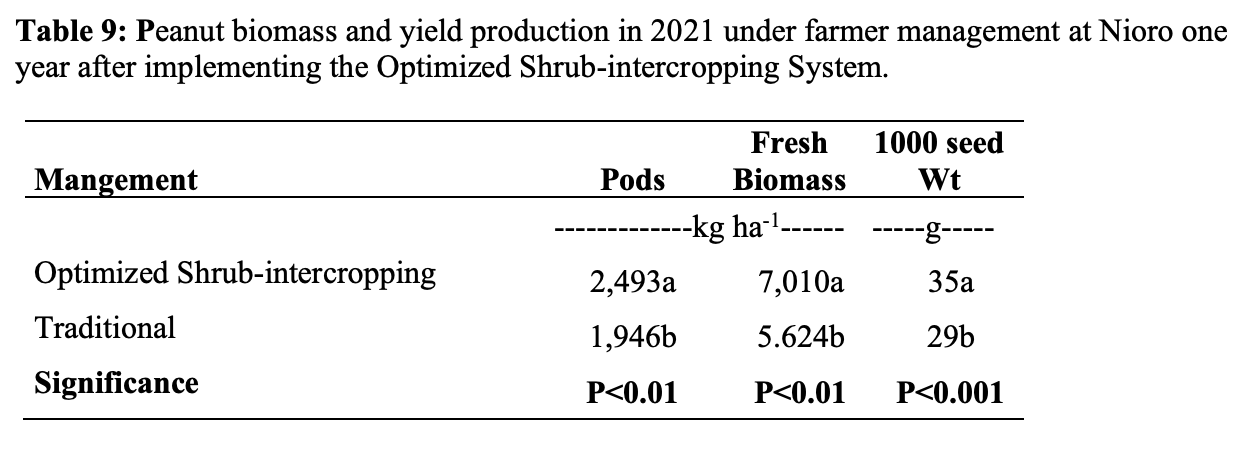
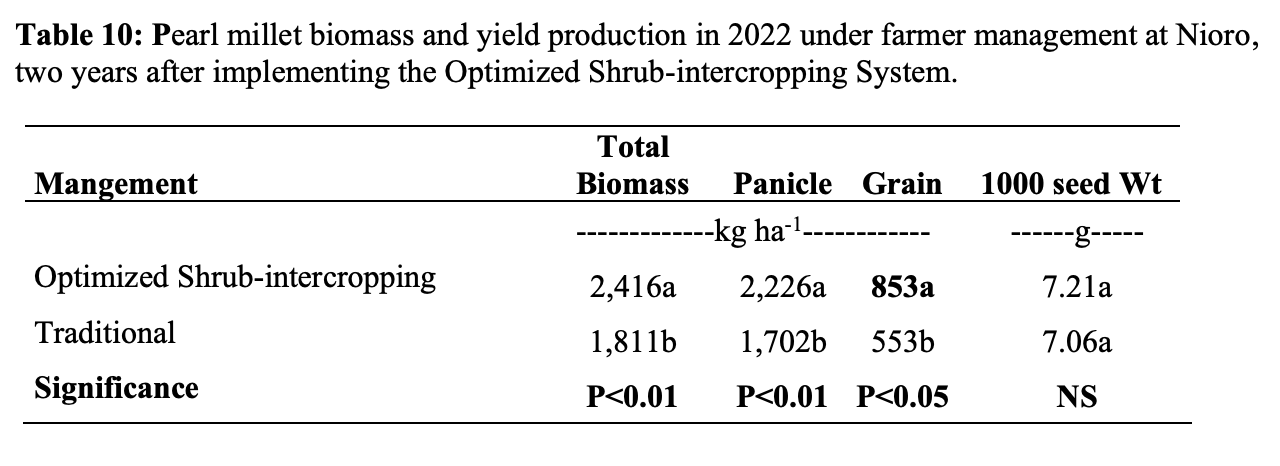



 Print
Print Email
Email

